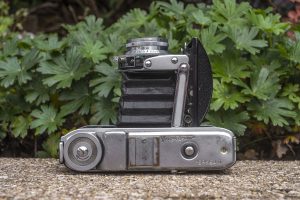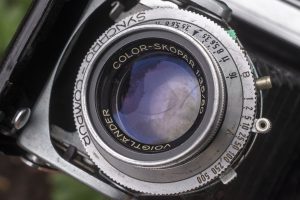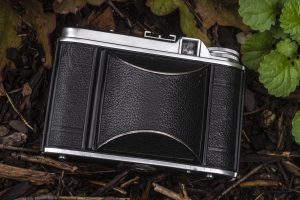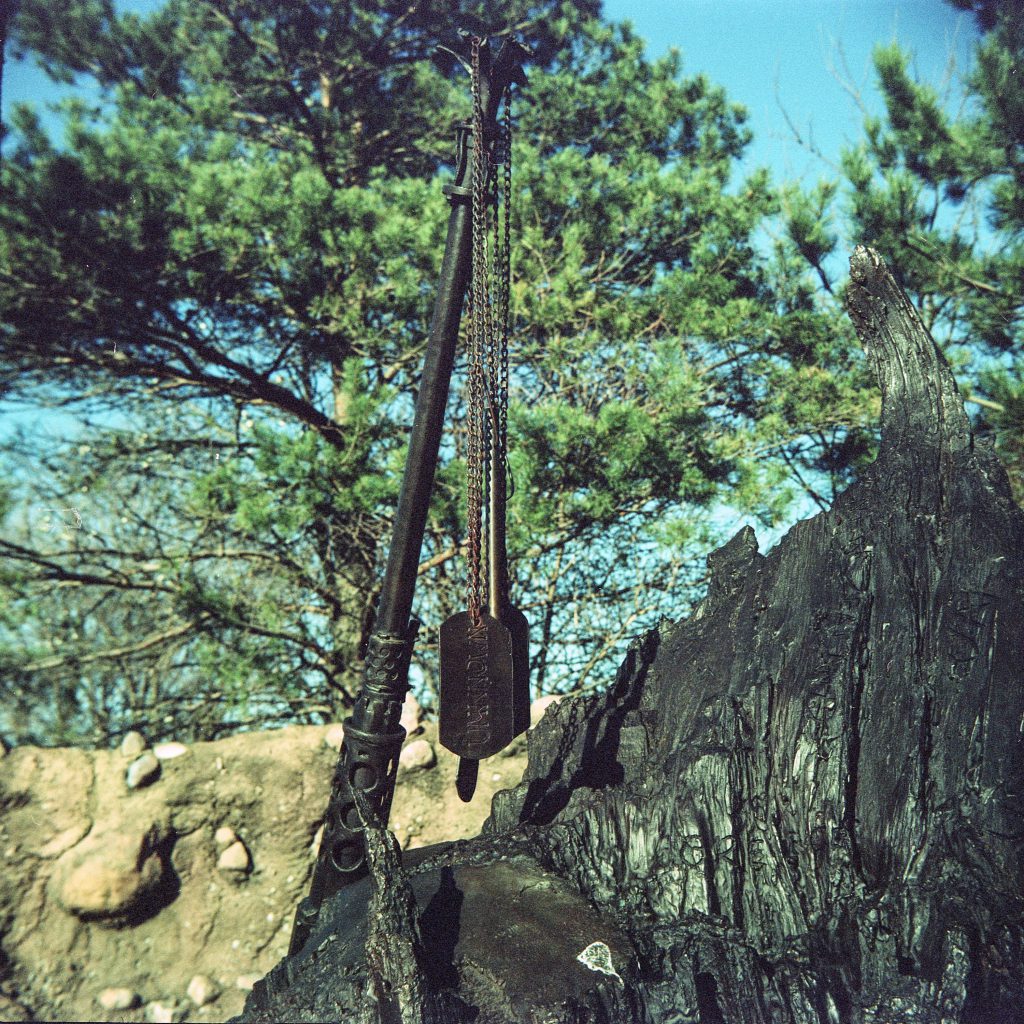This is a Voigtländer Perkeo II, a folding medium format camera produced by Voigtländer AG Braunschweig of West Germany between the years 1952 and 1955. The Perkeo was a mid-level camera that shot 6cm x 6cm images on 120 roll film, built to good quality standards with a quality 4-element Color-Skopar lens and Compur shutter. The camera used a scale focus viewfinder and compact folding design that wasn’t much larger than folding 35mm cameras of the day, despite shooting images much larger than 35mm. The Perkeo II was an update from the original Perkeo adding an automatic exposure counter and double exposure prevention.
 Film Type: 120 Roll Film (twelve 6cm x 6cm exposures per roll)
Film Type: 120 Roll Film (twelve 6cm x 6cm exposures per roll)
Lens: 80mm f/3.5 Color-Skopar coated 4-elements
Focus: Variable if SLR, 2.6 feet to Infinity with Click Stops for Portrait, Group, and Scenery
Viewfinder: Scale Focus
Shutter: Synchro-Compur Leaf
Speeds: B, 1 – 1/500 seconds
Exposure Meter: None
Battery: None
Flash Mount: Coldshoe and M and X Flash Sync
Weight: 539 grams
Manual: https://www.cameramanuals.org/voigtlander_pdf/voigtlander_perkeo_ii.pdf
Manual (alternate version): https://www.pacificrimcamera.com/rl/00499/00499.pdf
How these ratings work |
The Voigtländer Perkeo II is a fantastic folding camera from the golden age of camera design. It’s got a compact body that is smaller than most 6×6 cameras, a fantastic lens and shutter, a compelling feature set including double image prevention and an automatic exposure counter, and excellent ergonomics. When I want a portable camera that doesn’t sacrifice performance, the Perkeo II is the camera I look for. | ||||||
| Images | Handling | Features | Viewfinder | Feel & Beauty | History | Age | |
| 2 | 2 | 2 | 1 | 2 | 0 | 30% | |
| Bonus | none | ||||||
| Final Score | 11.7 | ||||||
History

The name “Perkeo” has been used at least three different times on three different cameras, two of which were made by Voigtländer AG. The use of this word is likely taken from Clemens Pankert, who was more formally known as Perkeo of Heidelberg. He was a court jester of Elector Palatine Charles III Philip in Heidelberg and suffered from dwarfism. Pankert was the guardian of an extremely large wine vat contained within the cellars of Heidelberg Castle, known as the Great Heidelberg Tun. He has since become an unofficial mascot of the city and region. His name, stories and images have been connected with a variety of festivals, traditional songs, cultural and scientific institutions, hotels, restaurants and private companies ever since.
The use of the name “Perkeo” is likely to suggest a small or “dwarf-like” product such as a small camera. The first Perkeo camera was a compact magazine camera called the Perkeo N°140, produced by Dr. Rudolf Krügener in the late 19th century. Krügener’s Perkeo shot up to twenty-four 4cm x 4cm glass plates contained within a special light tight compartment.

In 1932, a second Perkeo model would make it’s debut, this time produced by Voigtländer AG Braunschweig. This Perkeo was a compact folding camera that shot 3cm x 4cm images on 127 format roll film. Although only ever labeled the Perkeo, this camera is commonly referred to as the Perkeo 3×4 to differentiate it from the third and final Perkeo.
Introduced in 1952, the third Perkeo was once again unrelated to either previous models, this time shooting 6cm x 6cm images on 120 format roll film. Although larger than the Perkeo 3×4, compared to other 6×6 folding cameras, the new Perkeo was still quite compact, being only slightly larger than Voigtländer’s 35mm Vito.
The Perkeo was very similar to the earlier Bessa 66, featuring a rigid reverse Galilean viewfinder in a chrome top plate, self-erecting lens and shutter, leather bellows and featuring Prontor or Compur leaf shutters and a variety of Vaskar and Skopar lenses. The Perkeo was a well built camera and in the case of the Perkeo II, had a couple of innovative features not seen on lesser folding cameras, such as an exposure counter with automatic film stop and double exposure prevention. Loading a new roll of film into the camera only required you to use the red window on the back for the first exposure, and then the camera would handle frame spacing for the rest of the roll.

In the United States, Willoughby’s of New York was the primary importer of Voigtländer cameras, and when they first went on sale, the Perkeo I had a retail price of $49.50. The Perkeo II with it’s upgraded lens, shutter, and advancements to the film transport cost $83. Both these prices compare to $480 and $805 today.
Both the Perkeo I and II would be in production until 1955, when a third model called either the Perkeo III or E depending on the market, would debut with an uncoupled rangefinder on top. This final Perkeo would only be available for two years, discontinued shortly after Voigtländer’s acquisition by the Carl Zeiss Foundation in 1956.

In the years since the last of the Perkeos were made, a rumored “Super Perkeo” has appeared with a bottom folding door, coupled rangefinder, and what looks to be an uncoupled selenium exposure meter up top. This model, simply called the Type 176, never went into production, and only one is thought to exist. Had it been made though, it would have been in an exclusive class as there weren’t many other folding medium format rangefinder cameras with an exposure meter.
Dramatic changes to the German camera landscape, plus a shift in buying habits from customers away from folding cameras led to the end for cameras like the Perkeo, but in the years since it was discontinuation, compact folding 6×6 cameras remained popular for those who want a large negative in a compact camera. Compact cameras like the Perkeo more easily fit into the luggage or a handbag compared to a TLR or medium format SLR like the Pentacon Six, yet are capable of images with similar quality
Today, the Perkeo is a less talked about model compared to other similar cameras, but for those who own and still shoot them, you’ll often find a very strong loyalty to them. The Perkeo II’s small size, combined with excellent lens and shutter, and convenient features make it an excellent travel camera. You could certainly do a LOT worse than the Perkeo II.
My Thoughts

I often see questions from people new to film photography asking what are some recommendations for an inexpensive entry into medium format. Twin Lens Reflex cameras like the Rolleiflex and it’s clones are extremely popular, as are the many excellent SLRs made by Mamiya like the M645 and RZ67, but each of these cameras can be quite expensive, and they’re not exactly compact.
For those looking for a discount option or for something more portable, recommendations often shift to folding cameras, and one company that made quite a number of excellent examples was Voigtländer with their Bessa and Perkeo series.

The Perkeo II, reviewed here is a wonderfully compact folding 6×6 camera with some of the best ergonomics of any camera in this style I’ve used. Placed next to a Voigtländer Vito II 35mm camera, and an ANSCO B2 Commander 6×6 folding camera, the Perkeo II falls squarely in the middle of the two in terms of size. In fact, without these other cameras next to it for comparison, the camera does not appear to be large enough to support 120 roll film.

From the top down, the Perkeo continues it’s resemblance to a slightly larger Vito II, with a right hinged door, top plate shutter release, automatic resetting exposure counter, accessory shoe and film advance knob. Even the shape of the doors look almost identical.

The bottom of the camera has a centrally located 3/8″ tripod socket which in this example has a 1/4″ adapter, the door release button, and on each side, two small feet that help the camera sit level when placed on a flat surface. Also notice on the far right side, is the edge of the door release latch on the side of the camera.

The camera’s left side is where the door release is for the film compartment. The Perkeo II has a fairly secure method for opening the door which requires you to squeeze two buttons at the top and bottom of the latch while simultaneously pulling the door outward. This method all but guarantees that the film compartment can’t be accidentally opened with film loaded into the camera.

The film compartment is fairly typical of a 6×6 folding camera, but has a couple of nice touches indicative of a quality camera. For starters, the film pressure plate is extra large with divots on it to reduce friction as film passes across it. Film transports from right to left over a toothed shaft next to the supply spool which is how the exposure counter works. There is an extra metal roller on the door, immediately above this toothed shaft to ensure proper operation of the exposure counter. Inserting a new roll of film into the supply side is incredibly easy as there are no posts or keys to work around. Simply press in the new cassette and that’s all.
For the take up side, the bottom post swings out allowing you to rest an empty spool on it, and while pulling up on the film advance knob, the key is lifted out of the way, allowing you to swing the bottom post and spool back into position. Loading film into the Perkeo is one of the smoothest of any folding roll film camera I’ve used as I did not feel like I ever had to struggle with either of the spools like sometimes happens on other cameras.

The back of the camera has a red window with hinged door to protect the film inside from unwanted light leaks. A red “X” is visible in the window when the door is shut. Rotate the textured knob next to it clockwise and the door opens. You only need this red window to get the film to the first exposure after loading in a new roll as the automatic exposure counter will take care of the rest of the images.
There is a lever on the back of the top plate behind the shutter release which engages and disengages the exposure counter and film advance knob for loading in a new roll of film. With it pointing to the right, the exposure counter is engaged, but turn it to the left and the counter does not work, allowing you to freely roll the film without anything stopping it. This is useful after loading in a new roll for getting through the paper leader, but could also be useful if you have a camera where the exposure counter isn’t working, you would leave this to the left, and just use the red window for all 12 exposures.
Also notice there is a Kodak Tri-X Pan sticker on the back of the camera, placed there by some previous owner. Normally when I encounter cheat sheets like this on cameras, I usually take them off, but the sticker was in good shape and I liked the look of it, so I left it there as I feel it’s part of the camera’s history now.

Of all Perkeos, the Perkeo II offers the highest spec Color-Skopar lens and Synchro-Compur shutter combination. Like most other Compur shutters, all of the critical controls can be seen from the top down. Shutter speeds are controlled via the ring around the shutter. There are two shutter speed scales so that you can see the selected speed both from the front of the camera and above. The Perkeo does not have a self cocking shutter, so this must be done manually with the lever next to the flash sync port. The aperture is controlled with the slider closest to the bellows, and finally focus is controlled by rotating the front element group which has distances indicated in feet.

Beneath the lens and shutter are two chrome buttons which must be pressed at the same time to collapse the shutter and fold the camera shut. Also notice the tiny swing out foot on the far edge which is useful for balancing the camera on a flat surface when laying it on it’s side. This is a feature sorely missing from every folding Kodak Retina.

The viewfinder on the Perkeo is very small and basic and is the one area I didn’t love about the camera. While more than adequate for other pre and early post-war cameras, I feel that had Voigtländer taken the time to give it a slightly bigger viewfinder, the Perkeo II may have ranked as my favorite folding camera in my entire collection. That said, it’s certainly isn’t any worse than other similar cameras of the time and doesn’t detract from the use of this otherwise excellent camera.
There is a ton to like about the Perkeo II, from it’s excellent ergonomics, long list of features, excellent lens, and extremely small packaging, this could be the most ideal 6×6 folding camera ever made. Of course, things that look great on paper don’t always work out that way in real life, so keep reading!
My Results
I loaded up a roll of expired Portra 160NC into the Perkeo II and took it out with me to a pumpkin patch in late 2019, and then a funny thing happened… I forgot about it.
The camera sat on my shelf with only part of the roll shot until spring of 2020 when I finally realized that I still had exposures to shoot in it! Thankfully I realized this without opening the back and ruining the film. So the images below all come from the same roll of film, nearly six months apart.
After developing the roll of film from the Perkeo II, I noticed something odd that I am unsure is unique to my particular camera, or if all Perkeos are like, which is that I got thirteen exposures on a single roll of film. Looking at the gallery above, I only include 12 but there was a 13th exposure that I completely messed up on which I am not including.

It’s plausible I didn’t load the film correct, and just got lucky, but I noticed the frame spacing on the camera was very tight, with maybe 1mm space between each frame, and a 13th exposure on the tail of the film with more than enough room so that it didn’t get cut off. Whether this is an anomaly or something that can be repeated is anyone’s guess, but if others behave the same way, I’d consider getting an extra exposure on each roll of film to be a nice bonus.
Looking at the images, they’re all great and on par with those shot with other quality German made f/3.5 lenses. Center sharpness is as good as it gets, and although a very tiny bit of softness begins to creep in near the corners, it’s barely noticeable. I feel confident saying that images produced with this camera and lens would look indistinguishable as those shot with a Rolleiflex with 3.5 Zeiss or Schneider lenses.
The Voigtländer Perkeo II is almost perfect. It’s got top notch build quality, a great lens and shutter combination, is incredibly portable, and has some of the best ergonomics of any medium format folding camera I’ve used. The reason I say almost though is that there’s two small things that I think could have made the camera better. The viewfinder is just too small for a camera that was marketed entirely in the 1950s. Had the Perkeo been a model first released before the war and simply continued after, I could understand not wanting to redesign it, but for a company that was known for always being on the cutting edge in design and features, plus one that only a few years later would start putting HUGE viewfinders in their Vito and Prominent series, it’s disappointing to be limited to such a squinty viewfinder.

My second nitpick is that I wish the Color-Skopar had a tad wider focal length. At 80mm, it’s not an unusual focal length, but I think that had they widened it to 75mm or even 70mm, the increased depth of field would have made getting focused images just a bit easier, plus I tend to prefer slightly wide “primes” such as 40mm on 35mm cameras.
That said, these are just my two wish lists that would have made an already excellent camera even better. I always hate it when people say that something is “best in it’s class” but this is a case where it truly is. When I think of compact 6×6 folding cameras that are easy to use, have convenient features, and an excellent lens, the Voigtländer Perkeo II definitely is, the best in it’s class.
Related Posts You Might Enjoy
External Links
http://camera-wiki.org/wiki/Voigtl%C3%A4nder_Perkeo_(6×6)
https://certo6.com/camera-archive/voigtlander-perkeo-i-ii-iiie/
https://usingoldcameras.wordpress.com/2016/03/14/voigtlander-perkeo-ii-early-1950s/
https://filmosaur.wordpress.com/2014/01/23/meet-the-camera-voigtlander-perkeo-ii/















A great review of an outstanding camera. Voigtlander always seems to deliver! I had to put some limits on my acquisition of 120 folders- so I now only look at cameras with rangefinders -forgetting to focus is my main cause for folder foto failure. I also prefer 6×9. Your 6x6s here are pretty impressive, though. Thanks, Mike
I’m intrigued by this camera. I guess I just like folders with good lenses. Yet it looks like you weren’t in love with it?
I definitely liked the camera. My forgetfulness for finishing the roll comes from just too many cameras and too little time. My two nitpicks come as a result of not having any real cons to the camera. Had this had a slightly bigger viewfinder and a slightly wider lens would have made it absolutely perfect, but as it is, it’s still very, very good!
I concur with all the points in your review, Mike. I love my own Perkeo II, which I’ve had for about 10 years. In fact, I used it to shoot my own “official” self-portrait (shooting into a mirror) when I published a book of my photographs. What’s not to like about a high quality medium format camera that can fit in a jacket pocket?
Exactly, if there’s only one takeaway that I hope everyone who has never handled the Perkeo II before, is how small it is. This is a wonderfully compact camera that for it’s size, delivers excellent images!
The Perkeo is the best compact folder I’ve used for sure. Even the three-lens option (Vaskar 75 or 80 f/4.5) is really good. I actually prefer the rendering of it compared to the four-lens Xenar in my Rolleicord (I have a few Perkeo shots on flickr, like https://www.flickr.com/photos/bjornroth/28430188439/in/datetaken-public/lightbox/).
Great review (as always) Mike. I would add three points. Firstly, the Perkeo was designed to be used with the Kontur auxiliary viewfinder, and they are amazing; in fact anybody who uses a 120 folder should get one. Secondly, the 13th shot? Yes, that is renowned with the Perkeo and was advertised by Voigtlander as a selling feature. Finally, buyers should also be aware that the semi-automatic film advance in the Perkeo II is prone to breaking, and thus the Perkeo I is less likely to have problems, or need to be repaired.
As always, great feedback Cheyenne. I must have missed the advertisement about the 13th shot, but good to know this should be recreatable for others! And I will definitely have to look for one of those aux viewfinders and maybe even update the review if I ever do!
Hey Mike, did you ever get a Kontur finder? Also my Balda Super-Baldax arrived, shooting it last few days and it is the same size as the Perkeo, only a few millimetres higher but has coupled rangefinder, and mine has the super-rare 80mm f/2.8 Enna lens. Beautifully made and I have a close up filter I am trying for close up headshots.
I have never come across a Kontur finder. I remember when you mentioned it a while ago, it looked interesting, but I’ve had a bit of a “GAS-pause” lately, so I haven’t been looking. That Super Baldax certainly sounds interesting! I wish you lived closer because then it would be more cost effective to loan out some of these cameras to each other!
Mike, thanks for this, just as I was deciding I had all the Voigtländers I wanted, you come out with this. Of course I was aware of the Perkeo but decided I didn’t need it as it didn’t offer anything different to my others. Your very positive review is making me question that and I am right now resisting the urge to go check out the auction site
I don’t know if I should apologize or not! LOL! I guess I’m always happy to help other people spend their money! 🙂
I have a somewhat embarrassing collection of folders from the 30s, 40s and 50s, and the Perkeo is one of the few that I actually use to take actual pictures. (The Bessa II is another)
The Color Skopar is a Tessar, and perfectly sharp all the way to the corners, if stopped down just a little, and the Perkeo is small and easy to use. Maybe not as sharp as a Hasselblad, but fits in a coat pocket, which the ‘blad doesn’t.
Smaller than a Nikon F, and no grain at all with FP-4.
Many thanks for not just the excellent review – but also the Voigtlander trivia to include the prototype Type 176 Super Perkeo – which I’ve never seen before.
Yes, with modern film the Perkeo II yields 13 exposures. In 1952 the acetate film base was a bit thicker than today’s polyester base. If someone wishes to increase the spacing between each exposure on the negs, you need to add a layer or two of masking tape to the take up spool – but I never do.
Just rec’d my new-to-me Perkeo II and was looking for info on dating the camera as there doesn’t seem to be a serial number (that I can see). In poking around it does seem that these did have shutter variations. Mine has a Prontor-S on the 80/3.5 Color-Skopar.
Gary, I wish I had a better system for dating this camera, but many companies don’t make it very easy. I do not know of any way to accurately date your Perkeo II.